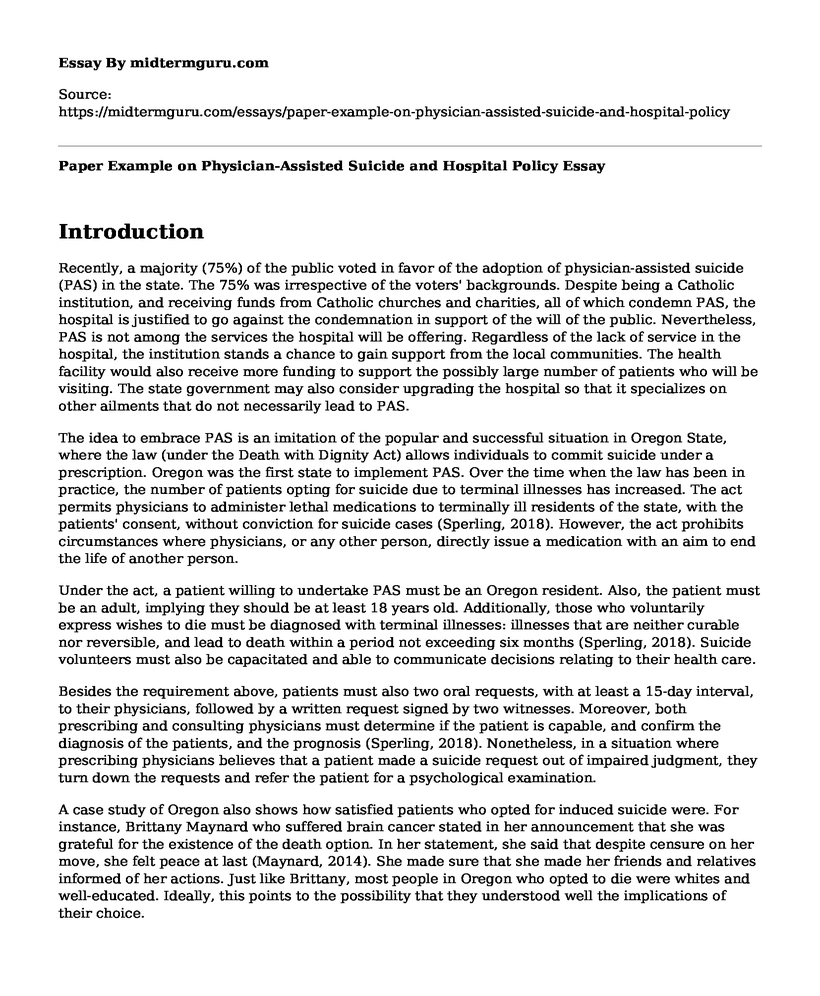Introduction
Recently, a majority (75%) of the public voted in favor of the adoption of physician-assisted suicide (PAS) in the state. The 75% was irrespective of the voters' backgrounds. Despite being a Catholic institution, and receiving funds from Catholic churches and charities, all of which condemn PAS, the hospital is justified to go against the condemnation in support of the will of the public. Nevertheless, PAS is not among the services the hospital will be offering. Regardless of the lack of service in the hospital, the institution stands a chance to gain support from the local communities. The health facility would also receive more funding to support the possibly large number of patients who will be visiting. The state government may also consider upgrading the hospital so that it specializes on other ailments that do not necessarily lead to PAS.
The idea to embrace PAS is an imitation of the popular and successful situation in Oregon State, where the law (under the Death with Dignity Act) allows individuals to commit suicide under a prescription. Oregon was the first state to implement PAS. Over the time when the law has been in practice, the number of patients opting for suicide due to terminal illnesses has increased. The act permits physicians to administer lethal medications to terminally ill residents of the state, with the patients' consent, without conviction for suicide cases (Sperling, 2018). However, the act prohibits circumstances where physicians, or any other person, directly issue a medication with an aim to end the life of another person.
Under the act, a patient willing to undertake PAS must be an Oregon resident. Also, the patient must be an adult, implying they should be at least 18 years old. Additionally, those who voluntarily express wishes to die must be diagnosed with terminal illnesses: illnesses that are neither curable nor reversible, and lead to death within a period not exceeding six months (Sperling, 2018). Suicide volunteers must also be capacitated and able to communicate decisions relating to their health care.
Besides the requirement above, patients must also two oral requests, with at least a 15-day interval, to their physicians, followed by a written request signed by two witnesses. Moreover, both prescribing and consulting physicians must determine if the patient is capable, and confirm the diagnosis of the patients, and the prognosis (Sperling, 2018). Nonetheless, in a situation where prescribing physicians believes that a patient made a suicide request out of impaired judgment, they turn down the requests and refer the patient for a psychological examination.
A case study of Oregon also shows how satisfied patients who opted for induced suicide were. For instance, Brittany Maynard who suffered brain cancer stated in her announcement that she was grateful for the existence of the death option. In her statement, she said that despite censure on her move, she felt peace at last (Maynard, 2014). She made sure that she made her friends and relatives informed of her actions. Just like Brittany, most people in Oregon who opted to die were whites and well-educated. Ideally, this points to the possibility that they understood well the implications of their choice.
Conclusion
PAS is coupled with some ethical dilemmas, including a concern over validation of patients' requests - valid requests are only of patients who can move their limbs (Goligher et al., 2017). Another ethical issue is the reason as to why a suffering person remains in that condition for as long as they do not meet the minimum requirements to grant suicide permission. However, like Oregon, relatives are always involved in the final decision making for a suicide application. Therefore, PAS should remain open to those willing to have it.
References
Goligher, E. C., Ely, E. W., Sulmasy, D. P., Bakker, J., Raphael, J., Volandes, A. E., ... & White, D. B. (2017). Physician-Assisted Suicide and Euthanasia in the Intensive Care Unit: a Dialogue on Core Ethical Issues. Critical Care Medicine, 45(2), 149.
Maynard, B. (2014). My Right to Death with Dignity at 29. CNN. November, 2.
Sperling, S. K. (2018). Oregon's Death with Dignity Act. JAMA oncology, 4(5), 747-748.
Cite this page
Paper Example on Physician-Assisted Suicide and Hospital Policy. (2022, Sep 26). Retrieved from https://midtermguru.com/essays/paper-example-on-physician-assisted-suicide-and-hospital-policy
If you are the original author of this essay and no longer wish to have it published on the midtermguru.com website, please click below to request its removal:
- Essay on the Impact of Supreme Court Decision on the Affordable Care Act
- Air Pollution in the World and Its Effects - Essay Example
- Research Paper on Pregnant Women in Prison
- Paper Example on Pathophysiology of Acute Respiratory Distress Syndrome
- Research Proposal: Malaria and Effectiveness of Using Insecticide-Treated Mosquito Nets
- Substance Abuse in Youth: Causes & Consequences - Essay Sample
- U.S. Jails & Prisons: More Deaths Despite Lower Population - Essay Sample







